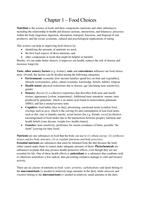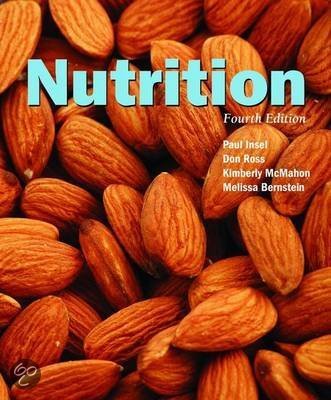Chapter 1 – Food Choices
Nutrition is the science of foods and their components (nutrients and other substances),
including the relationship to health and disease (actions, interactions, and balances); processes
within the body (ingestion, digestion, absorption, transport, functions, and disposal of end
products); and the social, economic, cultural and psychological implications of eating.
This science can help us improving food choices by:
identifying the amounts of nutrients we need,
the best food sources of those nutrients, and
other components in foods that might be helpful or harmful
Hereby, we can make better choices, it improves our health, reduces the risk of disease and
increases longevity.
Taste, other sensory factors (e.g. texture), costs and convenience influence our food choice
most. Overall, the factors can be divided among the following categories:
Environment: economic [low income families spend less on fruit and vegetables],
lifestyle [convenience, jobs], culture [customs, knowledge, beliefs, habits], religion
Health status: physical restrictions due to disease, age [declining taste sensitivity],
gender
Sensory: flavour [= a collective experience that describes both taste and smell],
texture, appearance [colour, temperature]. Additional taste sensation: umami; taste
produced by glutamate, which is an amino acid found in monosodium glutamate
(MSG), and has a meaty/savoury taste.
Cognitive: food habits [day-to-day], advertising, emotional needs [comfort food,
cravings such as pica, which is the craving for and consumption of non-food items
such as dirt, clay or laundry starch], social factors [by e.g. friends, social facilitation:
encouragement of food intake due to the interactions between people], nutrition and
health beliefs [cure disease, weight loss, health claims],
Genetics: taste sensitivity, preference for sweets avoidance of bitter, possible “fat
tooth” [craving for fatty food]
Nutrients are any substances in food that the body can use to (1) obtain energy, (2) synthesize
tissues and for body structure, (3) or regulate functions and body processes.
Essential nutrients are substances that must be obtained from the diet because the body
either cannot make them or cannot make adequate amounts of them. Phytochemicals are
substances in plants that may possess health-protective effects, even though they are not
essential for life. One of these health effects is antioxidant [= a substance that combines with
or otherwise neutralizes a free radical, thus preventing oxidative damage to cells and tissues]
activity.
There are six classes of nutrients in food: water, proteins, carbohydrates and lipids belong to
the macronutrients [= needed in relatively large amounts in the diet], while minerals and
vitamins belong to the micronutrients [= needed in relatively small amounts in the diet].






